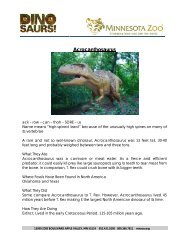2010 ANNUAL REPORT Minnesota Zoo
2010 ANNUAL REPORT Minnesota Zoo
2010 ANNUAL REPORT Minnesota Zoo
You also want an ePaper? Increase the reach of your titles
YUMPU automatically turns print PDFs into web optimized ePapers that Google loves.
and birds are known to eat figs. Some species of figs native to<br />
Africa can bear hundreds of thousands of fruits at maturity<br />
and grow so large that it would take up to ten people, holding<br />
hands, to circle the base of a single tree. Many fig trees,<br />
in turn, can be propagated only after being consumed and<br />
dispersed by animals. The animals need the forest, and the<br />
forest needs the animals.<br />
The unusual but ecologically-appropriate combination of<br />
animals—together with the complex, beautiful and interactive<br />
environment created for the animals and guests—have made<br />
Faces of the African Forest a popular and effective addition to<br />
the <strong>Zoo</strong>.<br />
“ We are very pleased with the new exhibit.<br />
The animals continue to impress us. The<br />
colobus monkeys stole the show right from the<br />
beginning, giving our guests an up-close view of<br />
their playful behaviors.”<br />
Tom Ness, <strong>Minnesota</strong> <strong>Zoo</strong> Tropics Trail Supervisor<br />
<strong>Minnesota</strong> <strong>Zoo</strong> <strong>2010</strong> <strong>ANNUAL</strong> <strong>REPORT</strong><br />
page 7



